《物理双语教学课件》Chapter 18 Capacitance 电容
高中物理静电场18电容器与电容课件新人教版选修共39页

1、合法而稳定的权力在使用得当时很 少遇到 抵抗。 ——塞 ·约翰 逊 2、权力会使人渐渐失去温厚善良的美 德。— —伯克
3、最大限度地行使权力总是令人反感 ;权力 不易确 定之处 始终存 在着危 险。— —塞·约翰逊 4、权力会奴化一切。——塔西佗
5、虽然权力是一头固执的熊,可是金 子可以 拉着它 Байду номын сангаас鼻子 走。— —莎士 比
46、我们若已接受最坏的,就再没有什么损失。——卡耐基 47、书到用时方恨少、事非经过不知难。——陆游 48、书籍把我们引入最美好的社会,使我们认识各个时代的伟大智者。——史美尔斯 49、熟读唐诗三百首,不会作诗也会吟。——孙洙 50、谁和我一样用功,谁就会和我一样成功。——莫扎特
高中物理课件电容器的电容

高中物理课件电容器的电容介绍电容器是物理学中的一个重要概念,它在高中物理课程中占据着重要地位。
本文将介绍电容器的基本概念、电容的计算方法以及电容器的一些应用。
电容器的基本概念电容器是一种用来存储电荷的装置。
它由两个导体板组成,中间由绝缘体(也称为电容介质)隔开。
当电容器上加有电压时,电荷会在导体板之间积聚,形成电场。
电容器的电容即为存储的电荷量和加在电容器上的电压之比。
电容的计算方法电容的计算可以通过以下公式得到:C = Q / V其中,C代表电容,单位为法拉(F),Q代表存储的电荷量,单位为库仑(C),V代表加在电容器上的电压,单位为伏特(V)。
在实际问题中,可以通过给定的条件来计算电容。
例如,当电容器上的电压为5伏特,电荷量为10库仑时,电容为:C = 10C / 5V = 2F电容器的应用电容器在电路中有广泛的应用,下面将介绍几个常见的应用场景。
1. 能量存储电容器可以存储电荷和能量,因此在电子设备中常被用来作为能量存储器。
例如,计算机主板上的电容器可以存储电能,为计算机提供稳定的电源。
2. 信号滤波电容器可以对信号进行滤波,去除高频噪声。
在放大器电路中,可以通过电容器来消除干扰信号,使得输出信号更加纯净。
3. 时间延迟电容器可以在电路中引入时间延迟。
通过调整电容的大小,可以使得电路的响应时间延长或缩短,从而实现不同的功能。
电容器作为一种重要的电路元件,在高中物理课程中有着重要的地位。
本文介绍了电容器的基本概念,电容的计算方法以及电容器在电路中的应用。
了解和掌握这些概念对于深入理解电路原理和解决实际问题具有重要意义。
希望通过本文的介绍,读者能够对电容器的电容有更清晰的理解,并在日常生活和学习中能够运用电容器的概念。
谢谢阅读!。
18电容器电容课件高二上学期物理教科版

18电容器电容课件高二上学期物理教科版一、教学内容本节课选自高二上学期物理教科版第四章第一节“电容器与电容”,具体内容包括:电容器的基本概念、电容的物理意义及其计算方法、电容器的连接方式及其电容变化规律。
涉及教材章节:第四章第一节。
二、教学目标1. 理解电容器的基本概念,掌握电容的物理意义及其计算方法。
2. 学会分析电容器连接方式,掌握电容变化规律。
3. 能够运用所学知识解决实际问题,提高学生的物理素养。
三、教学难点与重点难点:电容器的连接方式及其电容变化规律。
重点:电容器的基本概念,电容的物理意义及其计算方法。
四、教具与学具准备教具:电容器模型、演示电路板、多媒体课件。
学具:学生分组实验器材(电容器、导线、电阻、电压表、电流表等)。
五、教学过程1. 实践情景引入:展示电容器在生活中的应用,如电脑、手机等电子设备中的电容器,引发学生思考电容器的原理。
2. 基本概念讲解:讲解电容器的定义、构造及其工作原理。
3. 电容物理意义:通过例题讲解,阐述电容的物理意义,引导学生理解电容与电荷、电压之间的关系。
4. 电容计算方法:讲解电容的计算公式,推导电容器的电容与构造参数之间的关系。
5. 电容器连接方式:分析电容器串联、并联的连接方式,讲解电容变化规律。
6. 例题讲解:选取典型例题,讲解分析思路和解答方法。
7. 随堂练习:布置相关练习题,巩固所学知识。
8. 学生分组实验:让学生动手实践,验证电容器连接方式对电容的影响。
六、板书设计1. 电容器的定义、构造及工作原理。
2. 电容的物理意义及计算公式。
3. 电容器串联、并联的连接方式及电容变化规律。
4. 典型例题及解答过程。
七、作业设计1. 作业题目:(1)计算题:根据电容器的构造参数,计算其电容。
(2)分析题:分析电容器串联、并联连接方式对电容的影响。
2. 答案:(1)计算题答案:根据电容计算公式,代入构造参数计算得出。
(2)分析题答案:串联时电容减小,并联时电容增大。
人教版高中物理选修3-1课件《18电容器的电容》1
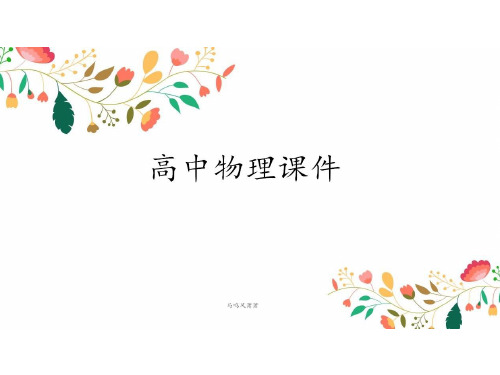
C.若A不动,将B沿图中虚线分开,则两边的电荷量大 小可能不等,与如何分有关
D.只要A与B不接触,B的总电荷量总是为零
4.先让验电器带上少量正电荷,然后拿一个 带负电的带电体逐渐接近验电器的金属球,可 以看到这样的现象:金属箔张开的角度先是减 小,以至闭合,然后又张开了,解释这个现象。
2.把两个完全相同的金属球A和B接触一下, 再分开一段距离,发现两球之间相互排斥,则 A、B两球原来的带电情况可能是() A.带有等量异种电荷 B.带有等量同种电荷 C.带有不等量异种电荷 D.一个带电,另一个不带电
3.如图所示,A、B是被绝缘支架分别架起的金属球, 并相隔一定距离,其中A带正电,B不带电,则以下说 法中正确的是( )
2.电荷及其相互作用:同种电荷相互排斥,异种电 荷相互吸引。
3.带电体能够吸引轻小物体
思考:物体原来不带电,摩擦后为何能带电?
二、带电方式的分析
1.摩擦起电的微观解释
演示实验
结论:摩擦起电的实质是物体间的电荷转移, 失电子的物体显正电;得电子的物体显负电。
2.接触起电
+#43;
++
++
++
接触前接触接触后
注意:所有带电体的电荷量或者等于e,或者 等于e的整数倍。电荷量是不能连续变化的物 理量。最早由美国物理学家密立根测得。电 子和质子的带电量称为元电荷,因为所有带 电体的电荷量都是e的整数倍。
实践与练习
1.有三个完全一样的绝缘金属球,A球带的 电荷量为q,B、C均不带电。现要使B球带的 电荷量为3q/8,应该怎么办?
空白演示
物理课件高二物理《电容器的电容》课件

充电过程中,电流逐渐减小。
详细描述
随着电容器两极板间电压的升高,电容器对电流的阻碍 作用逐渐增大,导致充电电流逐渐减小。
电容器放电过程
总结词
电容器通过导电回路将储存的电荷释放出来的 过程。
01
总结词
放电过程中,电流逐渐减小。
03
总结词
放电过程中,能量转换成其他形式的能量。
05
02
详细描述
电容器放电时,储存的电荷通过导电回路释 放出来,形成电流。电流的方向与电容器两 极板间电场的方向相反。
04
CHAPTER
电容器的充放电过程
电容器充电过程
总结词
电容器通过与电源相连,正负极板分别积累正负电荷的 过程。
详细描述
电容器与电源连接后,电源正极与电容器正极板相连, 电源负极与电容器负极板相连,导致正负电荷分别在正 负极板上积累,形成电场。
总结词
电容器储存的电荷量与电压成正比。
详细描述
电容器充电过程中,随着电荷的积累,电容器两极板间 的电压逐渐升高,直至达到电源电压。此时,电容器储 存的电荷量最大。
电容器定义
总结词
电容器是一种能够储存电荷的电子元 件。
详细描述
电容器是由两个平行、相互靠近的导 体(通常为金属箔或金属板)所组成 的电子元件。当电压施加在电容器上 时,电容器会储存电荷,形成电场。
电容器的工作原理
总结词
电容器通过利用静电感应原理来储存电荷。
详细描述
当电压施加在电容器上时,电容器两极板之间会产生电场,使正电荷被吸引到 负极板,负电荷被吸引到正极板,从而形成电荷的储存。
学习目标
知识目标
理解电容器的定义、性质和分 类。
18电容器的电容课件人教版选修3-1
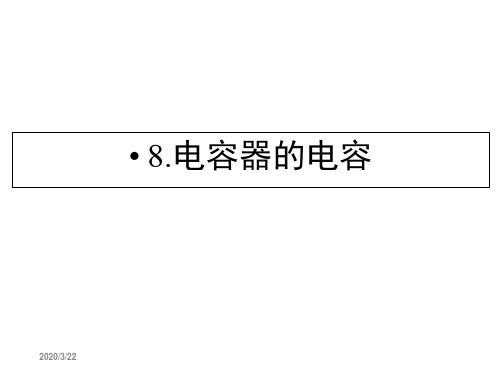
2020/3/22
解析: C=QU11=3×10-6 F=3 μF; 由C=UQ22--UQ11,求出U2=12 V; 由ΔQ′=CΔU′=C(U1-U2′)=1.2×10-5 C. 答案: 12 V 3 μF 1.2×10-5 C 【反思总结】 电容器的电容是反映电容器本身容纳电荷 本领的物理量,对一个特定的电容器来说是固定不变的,因而 能够推出公式 C=ΔΔQU.
带电和带哪一种电荷的仪器,通常所用的一种
验电器叫金箔验电器.金箔验电器是利用同种
电荷相斥、异种电荷相吸的原理制成的,其构
造如图甲所示.在一个金属棒的上端装一个金
• 属球,在其下端贴两条很薄的金属箔片,
• 金属棒插在用绝缘体制成的瓶塞中,瓶塞
• 塞在玻璃瓶或有玻璃窗的金属盒子上.
2020/3/22
• (2)静电计是用来测量导体的电势和导体间 电势差的仪器,把金箔验电器的玻璃瓶改 为有玻璃窗的金属盒,箔片改为带有刻度 的金属指针(图乙),就成为一个静电计.
的电容器.
等量
• 2.带电特点:两极板电荷
相对两板的内侧.
匀强电场
• 3.板间电场:板间形成
为E=U/d,方向垂直板面.
异号,分布在 ,场强大小
2020/3/22
• 四、平行板电容器的电容
• 1.实验:探究影响电容的几个因素
• (1)实验方法:控制变量
法.
• (2)实验目的:探究影响平行板电容器电容的 因素.
、厚度小于极板间距的陶瓷板,电容将增大 • D.在下板的内表面上放置一面积和极板相等
、厚度小于极板间距的铝板,电容将增大
2020/3/22
• 解析:
• 答案: BCD
2020/3/22
最新-2021学年高中物理选修31课件:18电容器的电容 精品

【解析】
由C=
Q U
可得
Q U
=
Q-3×10-6 U
C
,解得Q=4.5×10-6
3
C,故B正确;当U1=5 V时,C1=UQ1=4.5×510-6 F=0.9 μF;当U2= 5×10-7 V时,C2=UQ2=45.5××1100--76 F=9 F.这么大的电容可以说在哪
里都没有,F的单位非常大,一般的电容都是μF以及pF.故电压不可能
Q U
来定义,但电容的大小与Q、U无关.由公式C=
εrS 4πkd
知,影响电容
器电容大小的因素是电介质的相对介电常数εr,电容器极板的正对面 积S和极板间的距离d.
(2)通过Q-U图象理解,如图所示,Q-U图象是一条过原点的直
线,其中Q为一个极板上所带电荷量的绝对值,U为两板间的电势
差,直线的斜率表示电容大小.因而电容器的电容也可以表示为C=
ΔQ′=CΔU′=3×10-6×(10-6)C=1.2×10-5C.
据决定式C=
εrS 4πkd
可知,只有电容器极板间距离减半时,电容加
倍,故此时电容大小C′=2C=6 μF.
【答案】 3 μF 1.2×10-5C 6 μF
【方法归纳】
(1)公式C=
Q U
中的Q是指电容器一个极板所带电
荷量的绝对值;
二、电容
1.电容:电容器的带电荷量Q与电容器两极板间的电势差U的比
值叫做电容器的电容,用C来表示.
电容是描述电容器容纳电荷本领大小的物理量,电容越大,表示
电容器容纳电荷的本领越大.
2.定义式:C=UQ. 3.单位:法拉,简称法,用F表示,1法=1库/伏,即1 C/V;1 μF=10-6F,1 pF=10-12F.
电容CAPACITANCE.ppt
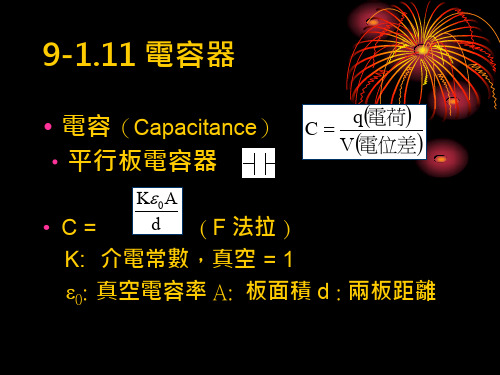
功率
• P(t)= I0V0Sin2 2 f t,取時間平
均值
1 P 2 I0V0
I0 2
V0 2
I V rms rms
• 對交流電而言,歐姆定律變成
Vrms I rms R
P
I V rms rms
Irms2 R
V2 rms R
Ex.14 72W 音箱
Vrms
V0 2
34V 2
9-2.4 Ohm’s Law
流過一電路元件之電流與該元件之 電位差成正比 電阻率與電場的大小及方向無關
iV E
R
J
I-V curves
conductor
semiconductor
Semiconductor半s導體
Superconductors超導體
Maglev、MRI and Tevatron
24V
I rms
Vrms R
24V 8.0
3.0
P I V rms rms 72W
பைடு நூலகம்
Ex.15 A practical example
Quebec Montreal
Pav E I (7.35105 V)(500A) 368MW
Pav,1 I 2R (500A)2 (0.22 / m 1000km) 55.0MW Pav,2 I 2R (1000A)2 (0.22 / m 1000km) 220MW
人體各部位的電位差
• 人體的肌肉及神經細胞利用鈉、鉀等 正離子及氯負離子執行生化機能;因 此造成之電場延伸至人體表面,形成 小量之電位差。
• 心電圖 -電極置於不同位置(A-B, B-C等)即決定不同形狀的心電圖。
18电容器的电容课件

18 电容器的电容课件一、教学内容本节课我们将学习第十八章“电容器的电容”,具体内容涉及教材第18章第1节,包括电容器的基本概念、电容的物理意义、电容的计算方法及其应用。
重点探讨电容的决定因素,理解电容器的功能以及在电路中的应用。
二、教学目标1. 理解电容器的基本概念,掌握电容的定义及其单位。
2. 学会计算电容器的电容,并能运用相关公式解决实际问题。
3. 掌握电容器的构造及工作原理,了解其在电子电路中的应用。
三、教学难点与重点重点:电容的定义、计算方法及应用。
难点:电容器的工作原理及其在电路中的具体应用。
四、教具与学具准备1. 教具:电容器模型、演示电路板、多媒体课件。
2. 学具:计算器、笔记本、文具。
五、教学过程1. 引入:通过展示日常生活中常见的电容器,如相机闪光灯的电容器,引导学生思考电容器的功能与应用。
2. 知识讲解:a) 电容器的概念、构造及工作原理。
b) 电容的定义、单位及其物理意义。
c) 电容的计算方法及决定因素。
3. 例题讲解:讲解电容器电容计算的典型例题,指导学生掌握计算方法。
4. 随堂练习:布置相关练习题,让学生独立完成,巩固所学知识。
5. 课堂讨论:针对练习题中的问题进行讨论,解答学生的疑惑。
6. 应用拓展:介绍电容器在电子电路中的应用,激发学生的学习兴趣。
六、板书设计1. 电容器的概念、构造及工作原理。
2. 电容的定义、单位、计算方法及决定因素。
3. 电容器在电子电路中的应用。
七、作业设计1. 作业题目:a) 计算给定电容器的电容。
b) 分析电容器在给定电路中的作用。
2. 答案:八、课后反思及拓展延伸1. 反思:本节课学生对电容器的概念、电容的计算方法掌握程度较高,但对电容器在电路中的应用还需进一步强化。
2. 拓展延伸:鼓励学生查阅资料,了解电容器在其他领域的应用,如电力系统、无线电通信等,提高学生的知识面。
重点和难点解析1. 电容的定义及其物理意义。
2. 电容的计算方法及决定因素。
2024年18电容器的电容课件
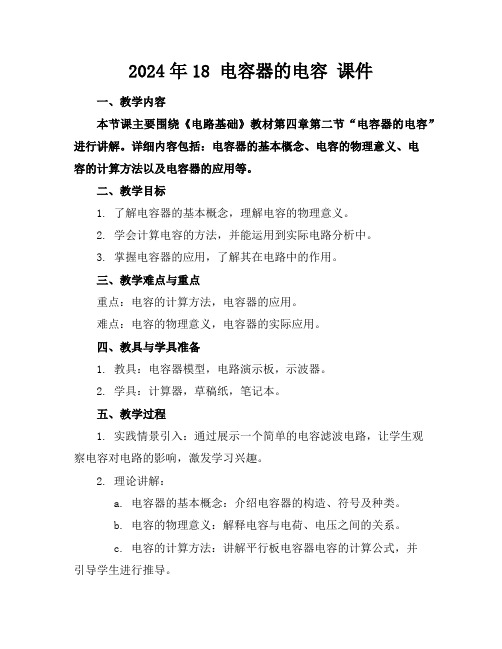
2024年18 电容器的电容课件一、教学内容本节课主要围绕《电路基础》教材第四章第二节“电容器的电容”进行讲解。
详细内容包括:电容器的基本概念、电容的物理意义、电容的计算方法以及电容器的应用等。
二、教学目标1. 了解电容器的基本概念,理解电容的物理意义。
2. 学会计算电容的方法,并能运用到实际电路分析中。
3. 掌握电容器的应用,了解其在电路中的作用。
三、教学难点与重点重点:电容的计算方法,电容器的应用。
难点:电容的物理意义,电容器的实际应用。
四、教具与学具准备1. 教具:电容器模型,电路演示板,示波器。
2. 学具:计算器,草稿纸,笔记本。
五、教学过程1. 实践情景引入:通过展示一个简单的电容滤波电路,让学生观察电容对电路的影响,激发学习兴趣。
2. 理论讲解:a. 电容器的基本概念:介绍电容器的构造、符号及种类。
b. 电容的物理意义:解释电容与电荷、电压之间的关系。
c. 电容的计算方法:讲解平行板电容器电容的计算公式,并引导学生进行推导。
3. 例题讲解:针对电容计算方法,选取典型例题进行讲解。
4. 随堂练习:让学生独立完成几道电容计算题目,巩固所学知识。
六、板书设计1. 电容器的概念、符号及种类。
2. 电容的计算公式。
3. 典型例题及解答步骤。
七、作业设计1. 作业题目:a. 计算给定平行板电容器的电容。
b. 分析一个实际电路中,电容器的作用。
2. 答案:八、课后反思及拓展延伸1. 反思:本节课学生对电容器的概念和电容的计算方法掌握程度,以及对实际应用的理解。
2. 拓展延伸:引导学生了解其他类型的电容器,以及电容器的其他应用领域,如振荡电路、滤波电路等。
重点和难点解析:1. 电容的物理意义。
2. 电容计算方法的推导和应用。
3. 电容器的实际应用。
4. 例题和随堂练习的选取与讲解。
5. 作业设计和答案的详尽性。
详细补充和说明:一、电容的物理意义电容的物理意义在于它能存储电荷,其容量大小反映了电容器在给定电压下存储电荷的能力。
18电容器电容课件高二上学期物理教科版
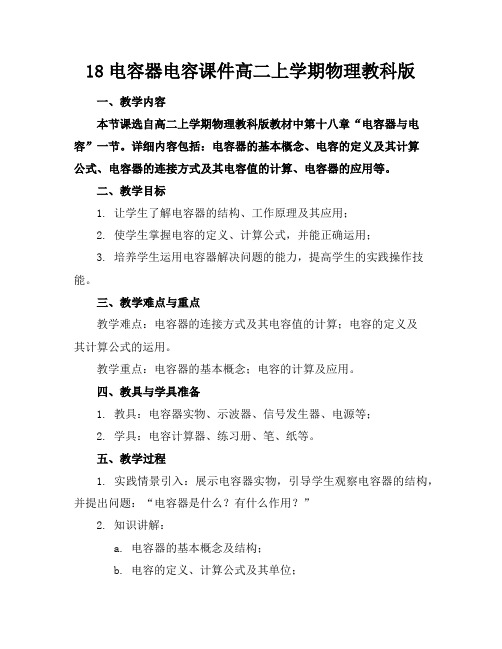
18电容器电容课件高二上学期物理教科版一、教学内容本节课选自高二上学期物理教科版教材中第十八章“电容器与电容”一节。
详细内容包括:电容器的基本概念、电容的定义及其计算公式、电容器的连接方式及其电容值的计算、电容器的应用等。
二、教学目标1. 让学生了解电容器的结构、工作原理及其应用;2. 使学生掌握电容的定义、计算公式,并能正确运用;3. 培养学生运用电容器解决问题的能力,提高学生的实践操作技能。
三、教学难点与重点教学难点:电容器的连接方式及其电容值的计算;电容的定义及其计算公式的运用。
教学重点:电容器的基本概念;电容的计算及应用。
四、教具与学具准备1. 教具:电容器实物、示波器、信号发生器、电源等;2. 学具:电容计算器、练习册、笔、纸等。
五、教学过程1. 实践情景引入:展示电容器实物,引导学生观察电容器的结构,并提出问题:“电容器是什么?有什么作用?”2. 知识讲解:a. 电容器的基本概念及结构;b. 电容的定义、计算公式及其单位;c. 电容器的连接方式及其电容值的计算;d. 电容器的应用。
3. 例题讲解:讲解电容计算、电容器连接方式等典型例题,引导学生分析解题思路和方法。
4. 随堂练习:布置与电容计算、电容器连接相关的练习题,让学生当堂完成,并及时给予反馈。
六、板书设计1. 电容器的结构、工作原理;2. 电容的定义、计算公式、单位;3. 电容器的连接方式及其电容值的计算;4. 电容器的应用。
七、作业设计1. 作业题目:a. 计算给定电容器的电容值;b. 根据电容器的连接方式,计算总电容;c. 分析电容器在给定电路中的应用。
2. 答案:八、课后反思及拓展延伸1. 反思:本节课学生对电容器的结构、工作原理及电容的计算掌握情况较好,但部分学生对电容器连接方式的计算仍存在困难,需要在课后进行巩固;2. 拓展延伸:引导学生了解电容器的其他类型及其应用,如可变电容器、超级电容器等,激发学生的学习兴趣。
重点和难点解析1. 电容器的连接方式及其电容值的计算;2. 电容的定义及其计算公式的运用;3. 实践情景引入和例题讲解;4. 作业设计。
29版人教版高中地理选修31课件18电容器的电容[可修改版ppt]
![29版人教版高中地理选修31课件18电容器的电容[可修改版ppt]](https://img.taocdn.com/s3/m/e0f3855a5727a5e9846a6120.png)
小试身手 1.电容器是一种常用的电子元件,对电容器认识正 确的是( ) A.电容器的电容表示其储存电荷的能力 B.电容器的电容与它所带的电荷量成正比 C.电容器的电容与它两极板间的电压成正比 D.电容的常用单位有μF 和 pF,1 μF=103 pF
解析:电容器的电容表示其储存电荷的能力,选项 A 正确;电容器的电容与自身的结构有关,与它所带的电 荷量及两板间的电压无关,选项 B、C 错误;1 μF=106 pF,选项 D 错误.
答案:A
知识点二 平行板电容器和常用电容器
提炼知识
1.结构:由两块彼此_绝__缘__、互相靠近的_平__行__金属
2.是否可以根据 C=QU认为,电容器的电容与电容 器所带电荷量成正比,与电容器两极板间的电势差成反 比?
提示:不可以,电容是电容器本身的一种属性,大小
由电容器自身的构成情况决定,与电容器是否带电,带多
少电荷量以及电容器两极板间的电势差均无关.
1.对电容的理解. (1)电容由电容器本身的构造决定. 电容器的电容是反映电容器容纳电荷本领的物理 量,用比值 C=UQ来定义,但电容的大小与 Q、U 无关.由
由 C=Δ ΔQU知,C=1.5×10-4 F, 设电容器原来的电荷量为 Q,则 Q=CU=4.5×10-4 C, 电容器的电容是由本身决定的,与是否带电无关, 所以电容器放掉全部电荷后,电容仍然是 1.5×10-4 F.
A.一定增大 C.一定不变 答案:B
B.一定减小 D.可能不变
拓展一 对电容的理解
1.照相机的闪光灯是通过电容供电的,拍照前先对 电容器充电,拍照时电容器瞬间放电,闪光灯发出耀眼 的白光.拍照前、后的充电过程和放电过程,能量发生 怎样的变化?
- 1、下载文档前请自行甄别文档内容的完整性,平台不提供额外的编辑、内容补充、找答案等附加服务。
- 2、"仅部分预览"的文档,不可在线预览部分如存在完整性等问题,可反馈申请退款(可完整预览的文档不适用该条件!)。
- 3、如文档侵犯您的权益,请联系客服反馈,我们会尽快为您处理(人工客服工作时间:9:00-18:30)。
Chapter18 CapacitanceCapacitor is a device you can use to store energy as potential energy in an electric field. Capacitors also have many other uses in our electronic and microelectronic age. They are vital elements in the circuits with which we turn radio and television transmitters and receivers. Microscopic capacitors form the memory banks of computers.18.1 Capacitance1.The left figure shows some of the many sizes and shapes ofcapacitors. The right figure shows the basic elements of anycapacitor-two isolated conductors of arbitrary shape. No matter what their geometry, flat or not, we call these conductor plates.2.The following figure shows a less general but moreconventional arrangement, called a parallel-plate capacitor,consisting of two parallelconducting plates of area Aseparated by a distance d.The symbol that we use torepresent a capacitor is basedon the structure of aparallel-plate capacitor but is used for capacitors of all geometries.3.When a capacitor is charged, its plates have equal butopposite charge of +q and –q. However, we refer to the charge of a capacitor as being q, the absolute value of these charges on the plates.4.Because the plates are conductors, they are equipotentialsurfaces: all points on a plate are at the same electric potential.Moreover, there is a potential difference between the two plates. For historical reasons, we represent the absolute value of this potential difference with V.5.The charge q and the potential difference V for a capacitor areproportional to each other, That is, CVq . The proportionality constant C is called the capacitance of the capacitor. Its value depends only on the geometry of plates and not on their charge or potential difference.6. The SI unit of capacitance is coulomb per volt. This unit occurs so often that it is given a special name, the farad (F). The farad is a very large unit.Submultiples of the farad, such as themicrofarad (F F 6101-=μ) and thepicofarad (F pF 12101-=), are moreconvenient units in practice.7. Charging a Capacitor: See rightfigure.18.2 Calculating the capacitance1. There are four steps to calculate the capacitance of a capacitor:(1) assume a charge q on the plates; (2) calculate the electric field E between the plates in terms of this charge, usingGauss ’ law; (3) knowing E , calculate the potential differenceV between the plates ⎰-+=Eds V , in which the + and – remindus that our path of integration starts on the positive plate and ends on the negative plate; (4) calculate C.2. A parallel-plate capacitor : (1)A q σ= (2) 0εσ=E (3) 0εσdEd V == (4) dA d A V q C 00)/(εεσσ===. So the capacitance does indeed depend only on geometrical factors .3. A cylindrical capacitor : Figure shows, in cross section, a cylindrical capacitor of length Lformed by two coaxial cylindersof radii a and b. We assume thatb L >> so that we can neglect thefringing of the electric field thatoccurs at the ends of the cylinders. (1) Each plate contains a chargeof magnitude q. (2) Lr q E 02πε=. (3) )ln(2200a b L q r dr L q Eds V b a πεπε⎰⎰===-+. (4) )/ln(20a b L V q C πε==. We see that the capacitance of a cylindrical capacitor, like that of a parallel-plate capacitor, depends only on geometrical factors .4. A spherical capacitor : Figure can also serve as a central cross section of a capacitor that consists of two concentric spherical shells, of radii a and b. (1) Applying the Gauss ’ law, we have )4(200r E EA q πεε==, therefore (2) 204r qE πε=; (3) and then we have ab a b q r dr q V ba -==⎰02044πεπε. (4) Finally, ab ab C -=04πε. (5) An isolated sphere : we can assign a capacitance to a single isolated spherical conductor of radius R by assuming that the “missing plate ” is a conducting sphere of infinite radius . So R C 04πε=18.3 Storing Energy in An Electric Field1. Work must be done by an external agent to charge a capacitor . Starting with an uncharged capacitor, you remove electrons from one plate and transfer them one at a time to the other plate. The electric field that builds up in the space between the plates has a direction that tends to oppose further transfer. Thus as charge accumulates on the capacitor plates, you have to do increasingly large amounts of work to transfer additional electrons. We visualized the work required to charge a capacitor as being stored in the form of electric potential energy U in the electric field between the plates .2. Suppose that, at a given instant, a charge q ’ has been transferred from one plate to the other. The potential difference V ’ between the plates at that instant will be q ’/C. (1) If an extra increment of charge dq ’ is then been transferred, the increment of work required will be ''''dq Cq dq V dW ==. (2) The work required to bring the total capacitor charge up to a final value q is ⎰⎰===q C q dq q C dW W 022''1. (3) This work is stored as potential energy U in the capacitor so that22212CV or C q U ==. (4) The potential energy of a charged capacitor may be viewed as stored in the electric field between its plates.3. Energy density: (1) In a parallel-plate capacitor, neglecting fringing, the electric field has the same value for all points between the plates. Thus the energy density u , that is, the potential energy per unit volume between the plates , should also be uniform. (2) We can find u by dividing the total potential energy by the volume Ad of the space between the plates. 202020221)(212)/(2E d V Ad V d A Ad CV Ad U u εεε=====. (3) Although we derived this result for the special case of a parallel-plate capacitor, it holds generally, whatever may be the source of the electric field .18.4 Capacitor with a Dielectric1. If you fill the spacebetween the plates of acapacitor with adielectric , which is aninsulating material suchas mineral oil or plastic,Thecapacitance increased by anumerical factor κ,which is called the dielectric constant of the introducedmaterial. Table shows some dielectric materials and their dielectric constant.2. Another effect of the introduction of a dielectric is to limit the potential difference that can be applied between the plates to a certain value V max , called the breakdown potential . If this value is substantially exceeded, the dielectric material will break down and form a conducting path between the plates . Every dielectric material has a characteristic dielectric strength, which is the maximum value if the electric field that it can tolerate without breakdown. A few such values are list in the table.3. With a dielectric completely filling the space between the plates, the capacitance of a capacitor becomesair C C κ=, where air C is the value of the capacitance with only air between theplates.4. The effect of a dielectric can be summed up in more general terms: In a region completely filled by a dielectric material of dielectric constant κ, all electrostatics containing the permittivity constant 0ε are to be modified by replacing 0ε with 0εκ.18.5 Dielectrics: An Atomic ViewWhat happens, in atomic and molecular terms, when we put a dielectric in an electric field? There are two possibilities, depending on the nature of the molecules:1. Polar dielectrics: The molecules of some dielectrics, like water, have permanent electric dipole moments. In such materials (called polar dielectrics ), the electric dipoles tend to line upwith an external electric field as in above figure . The alignment of the electric dipoles produces an electric field that is opposite the applied field and smaller in magnitude than that field.2. Nonpolar dielectrics : (1) Figure (a) shows a nonpolardielectric slab with no external electric field applied. (2) In figure (b), an electric field0E is applied via a capacitor,whose plates are charged as shown. The effect of field 0E is aslight separation of the centers of the positive and negative charge distributions within the slab. The slab as a whole remains electrically neutral and –within the slab-there is no excess charge in any volume element. (3) Figure (c) shows that the induced surface charges on the faces produce an electric field'E in the direction opposite that of the applied electric field 0E . (4) The resultant fieldE inside the dielectric has the direction of 0E but is smaller in magnitude .3. Thus, the effect of both polar and nonpolar dielectrics is to weaken any applied field within them .18.6 dielectrics and Gauss ’ Law1. When we discuss the Gauss ’ law inchapter 16, we assumed that thecharges existed in a vacuum . Herewe shall see how to modify andgeneralize that law if dielectricmaterials are present. Right figureshows a parallel-plate capacitor ofplane area A, both with and without a dielectric. We assume that the charge q on the plates is the same in both situations.2. For the situation of figure (a), without a dielectric, we can find the electric field Aq E 00ε=. 3. In figure (b) with the dielectric in place, we can find the electric field between the plates by using the same Gauss ’ law.(1) However, now the surface encloses two types of charge: it still encloses charge +q on the top plate, but it now also encloses the induced charge –q ’ on the top face of the dielectric. The charge on the conducting plate is said to be free charge because it can move if we can change the electric potential of the plate. The net charge enclosed by the Gaussian surface in figure (b) is q-q’. (2) So, using Gauss ’ law, we have ⎰-==⋅'00q q EA A d E εε , or A q q E 0'ε-=. (3) The effect of thedielectric is to weaken the original field0E by the factor κ. So we may writeA q E E 00κεκ==. (4) Comparing above two equations, we have κq q q =-'. (5) By substituting for q-q ’ in the Gauss ’ law, we have ⎰=⋅)'(0dielectric with law Gauss q A d E κε. (6) This important equation, although derived for a parallel plate capacitor, is true generally and is the most general form in which Gauss ’ law can be written .4. Note that: (1) The flux integral now deals with E κ is sometimes called the electric displacementD , so that the11 Gauss ’ law can be written in the simplified form ⎰=⋅q A d D . (2) The charge q enclosed by the Gaussian surface is now taken to be the free charge only. The induced surface charge is deliberately ignored on the right side of this equation, having been taken fully into account by introducing the dielectric constant κ on the left side.。
